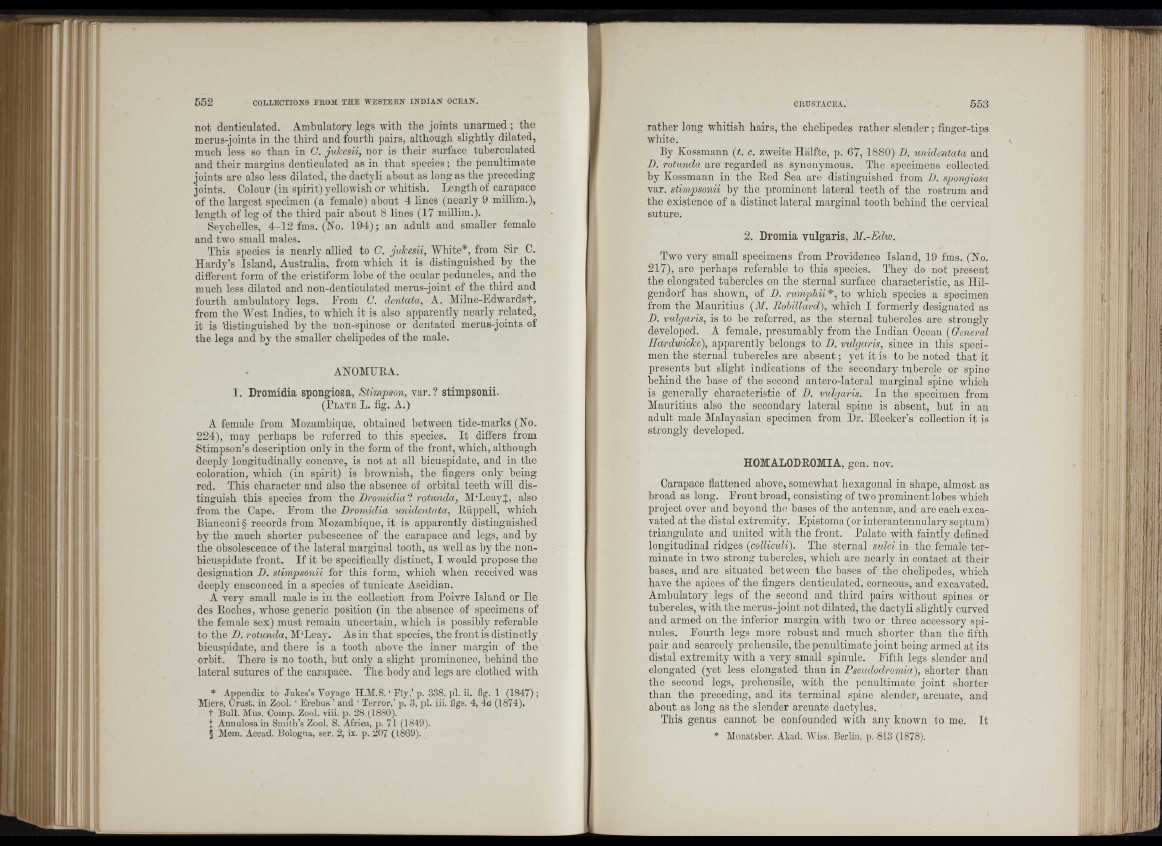
I) i
not denticulated. Ambulatory legs witb tbe joints unarmed ; tbe
merus-joints in tbe tbird and fourtb pairs, altbougb slightly dilated,
mucb less so than in C. jukesii, nor is their surface tuberculated
and their margins denticulated as in th at species; the penultimate
joints are also less dilated, the dactyli about as long as tbe preceding
joints. Colour (in spirit) yellowish or M’bitish. Length of carapace
of the largest specimen (a female) about 4 lines (nearly 9 millim.),
length of leg of the tbird pair about 8 lines (17 millim.).
Seychelles, 4 -12 fms. (No. 194); an adult aud smaUer female
and two small males.
This species is nearly allied to G. jukesii, White*, from Sir C.
Hardy’s Island, Australia, from which it is distinguisbed by the
different form of the cristiform lobe of the ocular peduncles, and the
mucb less dilated and non-denticulated merus-joint of tbe third and
fourth ambulatory legs. Lrom C. dentata, A. Alilne-Edwardsb,
from tbe West Indies, to which it is also apparently nearly rffiated,
it is 'distinguished by the non-spinose or dentated merus-joints of
the legs and by the smaller chelipedes of tbe male.
ANOAIUEA.
1. Dromidia spongiosa, Stimpson, var.? stimpsonii.
(P late L. fig. A.)
A female from Alozamhique, obtained between tide-marks (No.
224), may perhaps be referred to this species. I t differs from
Stimpson’s description only in the form of tbe front, which, altbougb
deeply longitudinally concave, is not at all bicuspidate, and in tbe
coloration, which (in spirit) is brownish, the fingers only being
red. This character and also tbe absence of orbital teeth will distinguish
this species from the Dromidia ? rotunda, Al‘Leay], also
from the Cape. Erom the Dromidia unidentata, Euppell, which
Bianconi § records from Alozamhique, it is apparently distinguisbed
by tbe much shorter iiubescence of tbe carapace and legs, and by
the obsolescence of the lateral marginal tooth, as well as by the non-
bicuspidate front. I f it be specifically distinct, I would propose the
designation D. stimpsonii for tbis form, which wben received was
deeply ensconced in a species of tunicate Ascidian.
A very small male is in tbe collection from Poivre Island or He
des Eocbes, whose generic position (in the absence of specimens of
tbe female sex) must remain uncertain, wbicb is possibly referable
to tbe D. rotunda, M‘Leay. As in th at species, tbe front is distinctly
bicuspidate, and there is a tooth above tbe inner margin of the
orbit. There is no tooth, bnt only a slight prominence, behind tbe
lateral sutures of tbe carapace. The body and legs are clothed witb
* Appendix to Jukes’s Voyage H.M.S. ‘ Fly,’ jj. 338, pi. ii. fig. 1 (1847);
Aliers, Crust, in Zool. ‘ Erebus ’ and ‘ Terror,’ p. 3, pi. iii. figs. 4, 4a (1874).
t Bull. Mus. Oomp. Zool. viii. p. 28 (1880).
1 Annulosa in Smith’s Zool. S. Africa, p. 71 (1849).
§ Alem. Accad. Bologna, ser. 2, ix. p. 207 (1869).
ratber long whitish hairs, tbe chelipedes rather slender; finger-tips
white.
By Kossmann (i. c. zweite Hälfte, p. 67, 1880) D. unidentata and
D. rotunda are regarded as synonymous. The specimens collected
by Kossmann in the Eed Sea are distinguished from D. spongiosa
var. stimpsonii by tbe prominent lateral teeth of the rostrum and
the existence of a distinct lateral marginal tooth behind tbe cervical
suture.
2. Dromia vulgaris, M.-Edw.
Two very small specimens from Providence Island, 19 fms. (No.
217), are perhaps referable to tbis species. They do not present
tbe elongated tubercles on the sternal surface characteristic, as Hilgendorf
has shown, of D. rumphii*, to wbicb species a specimen
from the Alauritius (ilf. Robillard), wbicb I formerly designated as
D. vidgaris, is to be referred, as the sternal tubercles are strongly
developed. A female, presumably from tbe Indian Ocean {General
Hardwicke), apparently belongs to D. vulgaris, since in this specimen
the sternal tubercles are ab sen t; yet it is to be noted th at it
presents but slight indications of the secondary tubercle or spine
behind the base of the second antero-lateral marginal spine which
is generally characteristic of D. vulgaris. In tbe specimen from
Alauritius also the secondary lateral spine is absent, but in an
adult male Alalayasian specimen from Dr. Bleeker’s collection it is
strongly developed.
HOMALODEOMIA, gen. nov.
Carapace fiattened above, somewhat hexagonal in shape, almost as
broad as long. Eront broad, consisting of two prominent lobes which
project over and beyond tho bases of the antennas, and are each excavated
at the distal extremity. Epistoma (or interantennulary septum)
triangulate and united with the front. Palate witb faintly defined
longitudinal ridges {coUiculi). Tbe sternal sidci in tbe female terminate
in two strong tubercles, which are nearly in contact at their
bases, and are situated between tbe bases of 'tb e chelipedes, which
have tbe apices of tbe fingers denticulated, corneous, and excavated.
Ambulatory legs of tbe second and third pairs without spines or
tubercles, witb the merus-joint not dilated, tbe dactyli slightly curved
aud armed on the inferior margin witb two or threo accessory spinules.
Eourtb legs more robust and much shorter than the fifth
pair and scarcely prehensile, tbe penultimate j oint being armed at its
distal extremity witb a very small spinule. Eifth legs slender and
elongated (yet less elongated than in Pseudodromia), shorter than
tbe second legs, prehensile, with the penultimate joint shorter
than tbo preceding, and its terminal spine slender, arcuate, and
about as long as tbe slender arcuate dactylus.
This genus cannot be confounded witb any known to me. I t
4-
J: 4
'
::f!| ' it
Grill
iii4- ll i
IriEi. U
:ri¡ ,1?^
ri) t
ri: i,.
4' I J
ii
I.i
■'I . i
.¡ri! :